Confederate Infantry Guide: Part 2

The following is a comprehensive list of all infantry units in the mod that are currently available to the Confederacy. This guide is intended to not only show what units are available, but to also give players a quick reference to where those units can be recruited from in the mod, the weapons they are equipped with, as well as which faction and generals they are currently assigned to.
This guide is organized according to the type of unit, their home state (in alphabetical order), and their designated number (if applicable).
Infantry
Tennessee
1st Tennessee Volunteer Infantry
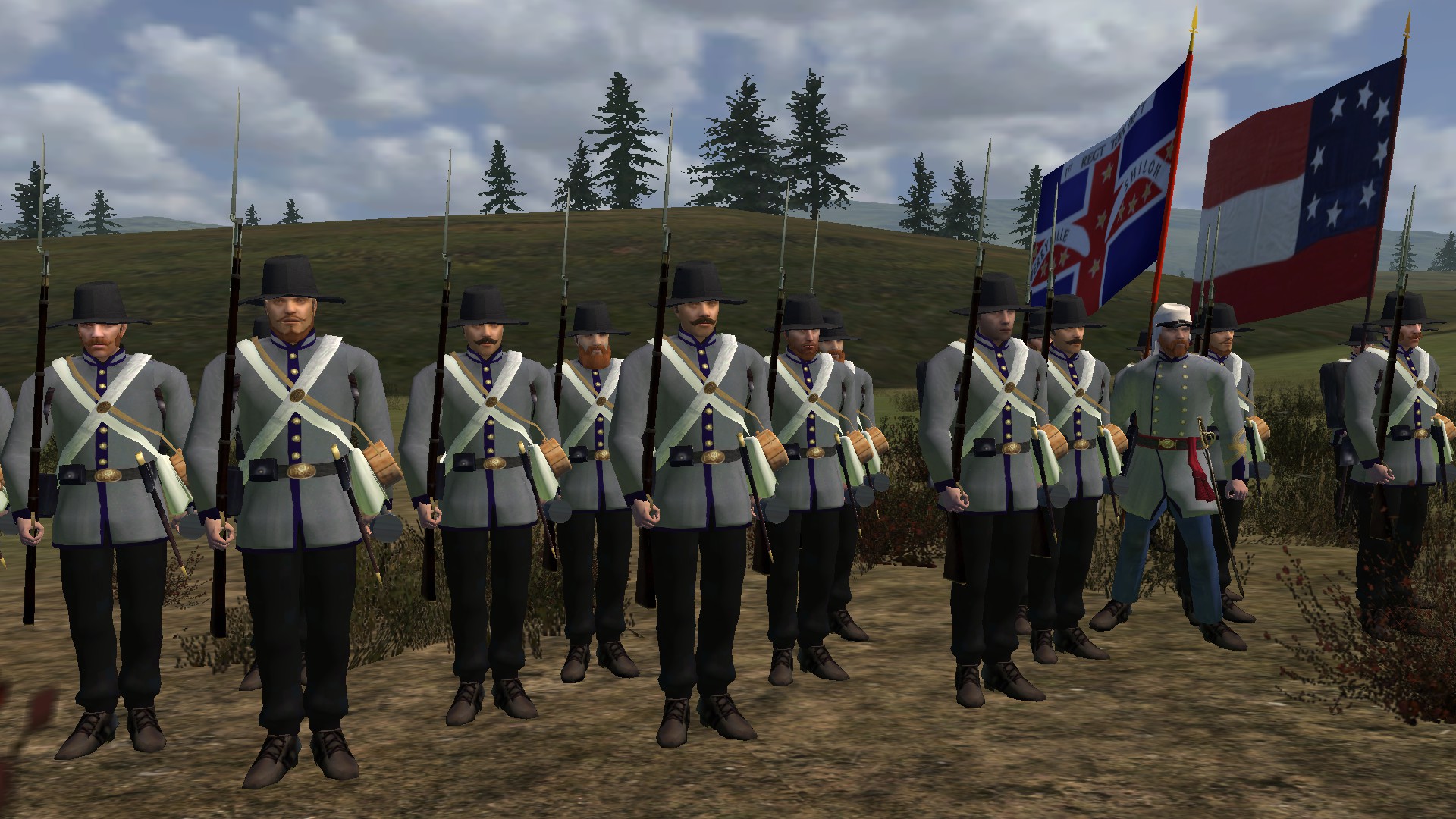
Weapons: Pattern 1853 Enfield Rifle Musket
Faction: Army of Tennessee
Current Commander: Major General Benjamin F. Cheatham
Recruitment Locations: Nashville, Fort Defiance, Fort Donelson, Chattanooga, Fort Henry, Hopkinsville, Franklin, Clarksville, Murfreesboro, Shiloh, Johnsonville
The 1st Tennessee Volunteer Infantry was originally organized on May 9th, 1861, and was officially mustered into Confederate service on August 1st of the same year. George Maney, who commanded the Rock City Guards battalion that became companies A, B and C, was elected colonel for the first 90 days. Colonel Maney was promoted to brigadier general for gallantry at Shiloh, and Captain Hume R. Feild was elected colonel at the reorganization. Feild remained in command for the duration of the war.
The regiment took part in the failed Cheat Mountain Campaign in West Virginia, lasting from September 10th to 15th, 1861. Although a minor action, this campaign is of interest because it was General Robert E. Lee's first campaign of the Civil War. Lee's biographer wrote, "His first campaign had ended ingloriously."
On December 8th, 1861, the regiment was ordered to Winchester, Virginia, where it formed part of the forces which Major General Thomas J. "Stonewall" Jackson led on his expedition to Bath, Virginia, and the banks of the Potomac River. After this campaign, the regiment was ordered to the West in February, 1862, and for the rest of the war, the regiment served in the forces which later came to be called The Army of Tennessee. Companies "F", "G", "H", "I", and "K", were sent forward, and reached Corinth in time to take an active part in the Battle of Shiloh. Colonel Maney joined the main battle about 2:30 P.M. on April 6th, and was directed by General Cheatham to select his own forces to lead a charge against a Federal position which had been stubbornly defended. With his own battalion and the 9th and 19th Tennessee Regiments, Colonel Maney led a charge which broke the enemy's lines, and led to their retreat to the river. General Cheatham described it as "one of the most brilliant, as it was certainly one of the most decisively successful, movements of the day." On the 7th, Colonel Maney was ordered to reinforce Brigadier General J. M. Withers, on the extreme right, who was being hard pressed, and with his battalion, led a charge which repelled the Federal advance. Major Hume R. Feild was in active command of the 1st Tennessee during the time Colonel Maney was acting as a brigade commander, and was highly commended for his efficiency.
From Corinth, the army withdrew to Chattanooga, Tennessee, and after only a brief pause, it left Chattanooga on August 19th for General Bragg's invasion of Kentucky. The regiment suffered heavy casualties in the Battle of Perryville on October 8th, 1862, losing more than half of its men in killed, wounded, and missing. As part of General Bragg's army it retreated into Tennessee, reaching Murfreesboro in November, 1862. It was again heavily engaged at the Battle of Murfreesboro on December 31st, 1862. Following this battle, in January, 1863, by order of General Bragg, the regiment was consolidated with the remnants of the 27th Tennessee Regiment to form the 1st/27th Consolidated Regiment.
There was little activity until the Battle of Chickamauga, where the regiment did valiant service. After Chickamauga, it was placed for a few weeks in Major General William H. T. Walker's Division for an expedition into East Tennessee. It returned in time to participate in the Battle of Missionary Ridge, still in Walker's Division, and helped cover the retreat to Dalton, Georgia. The 1st Tennessee held the fort in the famous "Dead Angle" in the Battle of Kennesaw Mountain, and after the Battle of Jonesboro, when General Joseph E. Johnston was replaced in command of the Army by Lieutenant General John B. Hood, the regiment went with Hood back into Tennessee, taking part in the Battles of Franklin and Nashville, in November and December, 1864.
After the defeat at Nashville, the army fell back across the Tennessee river, and the regiment halted at West Point, Mississippi for a short while. Then, after a long and tedious journey through Mississippi, Alabama, Georgia and South Carolina, it joined General Joseph E. Johnston at Bentonville, North Carolina where it was again engaged. In the final reorganization of Johnston's Army in April, 1865, the 1st/27th was consolidated with the 6th, 8th, 9th, 16th, 28th and 34th Infantry Regiments, and the 24th Battalion of Sharpshooters to form the 1st Consolidated Regiment of Tennessee Infantry. After the Battle of Bentonville, the regiment was surrendered by General Joseph E. Johnston at Durham, North Carolina on April 26th, 1865, and was paroled at Greensboro, North Carolina May 1st, 1865. Out of the nearly 1,200 men on the rolls of the 1st Tennessee, only 125 officers and men were left at the final surrender.
10th Tennessee Infantry "Bloody Tinth"
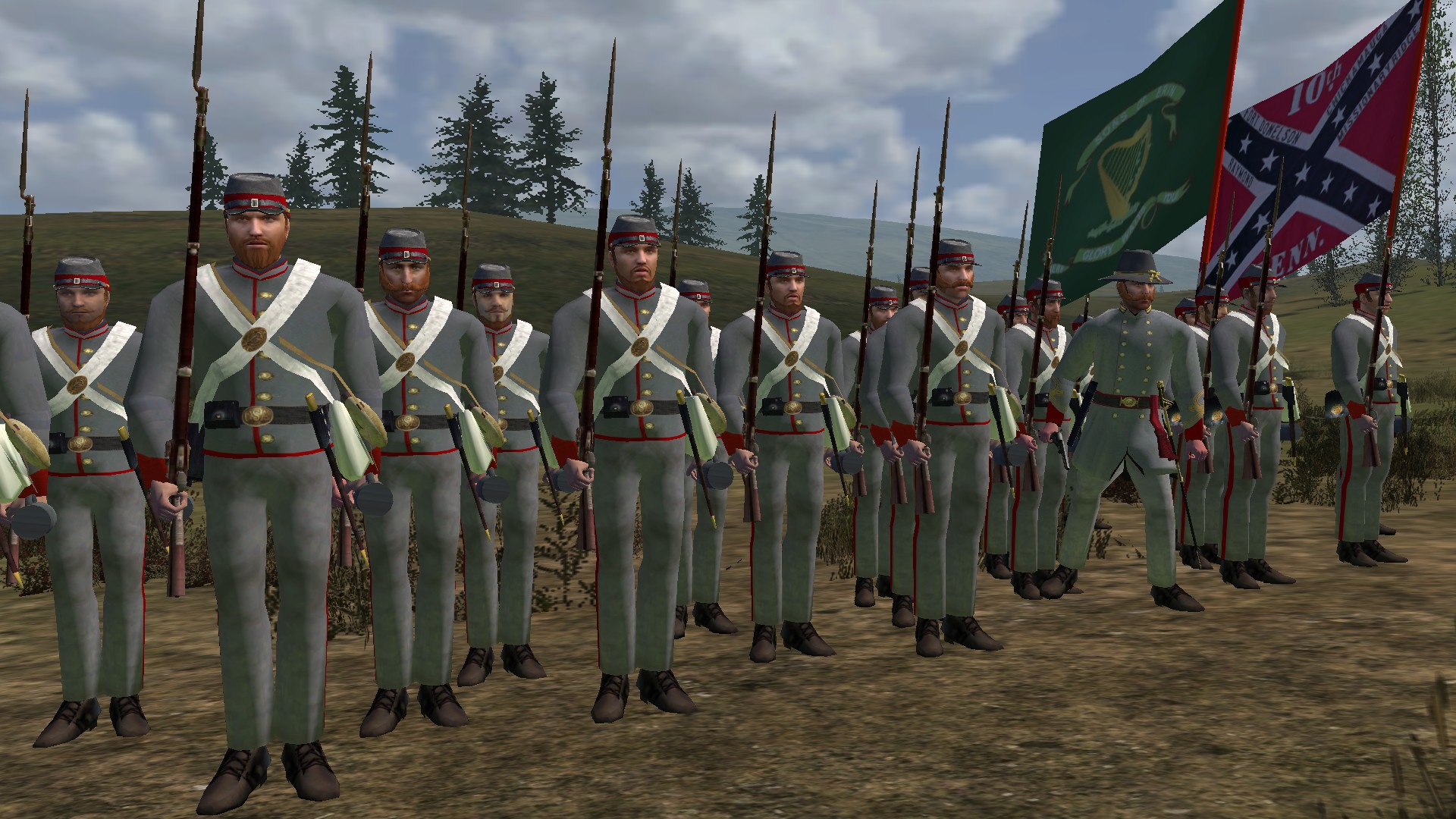
Weapons: (Buck & ball) Springfield Model 1816 Flintlock Musket
Faction: Army of Tennessee
Current Commander: Major General William H. T. Walker
Recruitment Locations: Nashville, Fort Defiance, Fort Donelson, Chattanooga, Fort Henry, Hopkinsville, Franklin, Clarksville, Murfreesboro, Shiloh, Johnsonville
The 10th Tennessee Infantry was organized at Fort Henry, on the Tennessee River, in May of 1861, just a few weeks after the first shots were fired at Fort Sumter. In July 1861, the 10th Tennessee was reported with 720 men armed with flintlock muskets, comprised of men from the Nashville area, as well as the Humphreys, Giles, Davidson, and Montgomery counties of Tennessee. Known as the "Bloody Tinth", it was one of only two Irish Catholic regiments in the Confederate Army, although their elected officers were mostly Ulster-Scots Protestants. The Regimental flag originally belonged to Company D of the Tennessee State Militia, and was outlined in Kelly Green on a light green background. A gold harp, maroon trim with white lettering; above the harp, "Sons of Erin"; below the harp "Go Where Glory Awaits You".
Initially serving at Fort Henry, the 720 men of the regiment were transferred to Ft. Donelson where it was part of Colonel Heiman's command which was surrendered in February 1862. Those taken prisoner at Donelson were eventually paroled at Vicksburg in September 1862 and the regiment was reorganized a short time later, with Randall McGavock replacing the deceased Colonel Heiman. The 10th was under fire at Mechanicsville, and took part in the desperate assault of Longstreet's Division on the enemy's position at Gaines' Mill, and emerged victorious, but at the loss of half of the 350 men that were engaged. Three days later, the regiment was in the line of assault at Frazier's Farm, where it met Meagher's 69th New York, the famed Irish Brigade. Of 180 men fit for duty, only 90 were present at regimental muster the next morning. The 10th again saw action at Chickasaw Bayou against General Sherman's forces in late December, 1862. The regiment's ranks soon began to fill up once more, and the 10th Tennessee marched with the Confederate army towards the Potomac river.
At the Second Battle of Manassas, the 10th Tennessee suffered under a destructive fire, and lost about 60 men, but was held in reserve. The regiment took part in the capture of Harper's Ferry, then crossed the river and fought obstinately at the Battle of Antietam, where it lost 67 killed and wounded. The 10th wintered at Rappahannock, and once again faced the Irish Brigade at Fredericksburg. At Salem Church, Wilcox's Alabama Brigade, of which it was attached, bore the brunt of the Union assault, and drove them back in confusion, capturing 1,500 prisoners. The 10th Tennessee lost 58 men killed and wounded. Early in 1863, the 10th was again transferred, this time to Port Hudson, Louisiana, before it was ordered back to Mississippi where it was heavily involved in the fighting at Jackson and Raymond. Colonel McGavock was killed in action during this engagement and was replaced by Lieutenant Colonel William Grace. It was in the army that Robert E. Lee led into Maryland for a second time, that the regiment's colors were flouted in the face of death once more at Gettysburg. In this battle, of 420 men of the 10th Tennessee who were engaged, 260 were left on the bloody field.
The 10th Tennessee re-crossed the Potomac with the army, and in September 1863, the regiment was ordered to join Bragg's Army of Tennessee in time for the battle of Chickamauga, at which under 200 men stood in its ranks; a figure that would drop to less than 70 by December of that year, with Colonel Grace among the dead. The 10th was moved between various divisions, but still managed to fight at Missionary Ridge. The regiment was again hotly engaged at the Wilderness, losing heavily, and suffered considerably at Spotsylvania Court House. It was under fire nearly every day as the Union army pressed up to Richmond, and the loss to the regiment was severe at Cold Harbor. At Petersburg the 10th again suffered heavily. It fought the cavalry raid on the Weldon Railroad, and participated in the capture of the Crater. At the Second Battle of Deep Bottom, the regiment participated with some loss, and lost heavily in the attempt to dislodge the enemy from their position on the Weldon Railroad. The regiment assisted in repulsing the Union army on the plank road below Petersburg, and following the carnage at Franklin, Colonel Grace was mortally wounded at Jonesboro on August 31st, 1864, and John G. O'Neill became colonel of the 10th in his stead.
As part of Bates' Division, the men of the 10th were assigned to General Forrest's operations against Union lines of communication and the demolition of bridges around Murfreesboro, Tennessee, before they returned to Hood's army to take part in the battle of Nashville. Here the 10th was fighting around the Shy's Hill area, where Bates saw his division destroyed with only 65 men, some from the 10th, managing to escape with their lives. These men rejoined what was left of Bates' Division which in turn joined up with General Johnston's army in North Carolina, taking part in the final battle at Bentonville on March 31st, 1865. The remnant of the 10th Tennessee indignantly denied the first rumors of the contemplated surrender, many wept at the announcement, and the survivors tore their battle worn flag into shreds to retain as a memento to their fallen comrades. What was left of the 10th formed part of the 4th Consolidated Tennessee Infantry Regiment which was finally paroled at Greensboro, North Carolina on May 1st, 1865.
20th Tennessee Volunteer Infantry
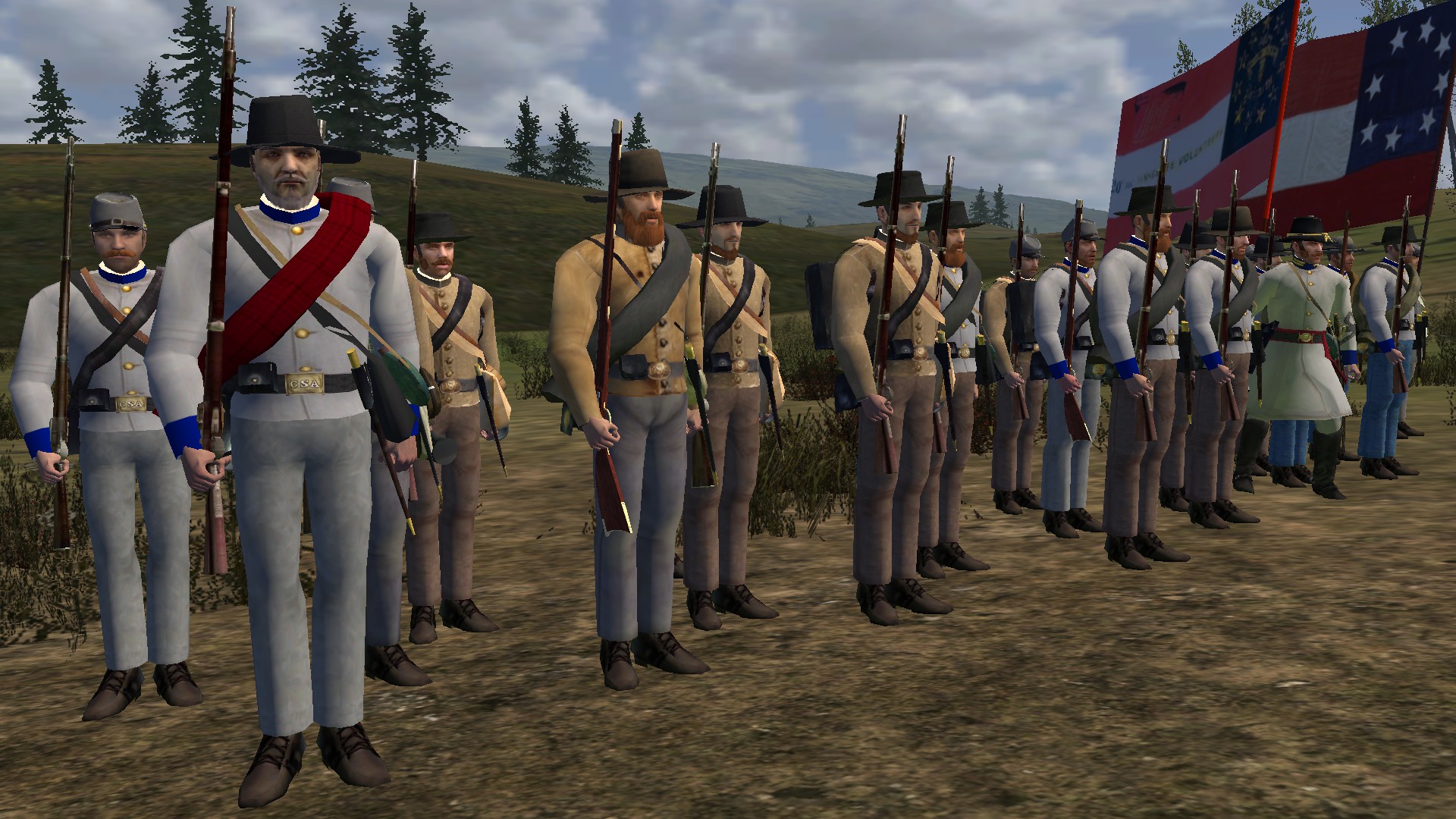
Weapons: (Buck & ball/rifle mix) Springfield Model 1816 Flintlock Musket, Springfield Model 1835 Flintlock Musket, Springfield Model 1822 Smoothbore Musket, Springfield Model 1842 Smoothbore Musket, Kentucky Rifle
Upgrades to: (Buck & ball/rifle mix) Springfield Model 1842 Smoothbore Musket, Pattern 1853 Enfield Rifle Musket, Springfield Model 1855 Rifle Musket, Springfield Model 1861 Rifle Musket, Lorenz Rifle Model 1854
Faction: Army of Tennessee
Current Commander: Major General Patton Anderson
Recruitment Locations: Nashville, Fort Defiance, Fort Donelson, Chattanooga, Fort Henry, Hopkinsville, Franklin, Clarksville, Murfreesboro, Shiloh, Johnsonville
With names like the Hickory Guards and the Swanee Rifles, the ten companies composing the 20th Tennessee Volunteer Infantry Regiment were organized during the months of May and June, 1861 from several different counties in middle Tennessee. They assembled at Camp Trousdale, where they were organized into this regiment, and where they were later mustered into Confederate service. By July of that year, the 20th reported 880 men and was led by 50 year old Joel A. Battle, a wealthy plantation owner from Davidson county and a veteran of the Seminole War. In the beginning, the regiment was very poorly armed, with many recruits performing drill and guard duty with sticks instead of rifles. Some had brought old flintlocks from home, and others were eventually armed with a collection of military antiques from the arsenal at Nashville.
The 20th Tennessee's first real taste of war was at the Battle of Mill Springs. Under the inexperienced leadership of Brigadier General Felix K. Zollicoffer, the regiment was cut to pieces, sustaining 110 casualties, which was a large amount considering it was a small engagement like so many in the beginning of the war. Many of their antiquated flintlocks were ineffective because of the dampness, "not one musket in ten would fire". General Zollicoffer, wearing a white raincoat, stumbled into Union lines and was shot and killed, making him the first Confederate general killed in the West. His death caused the demoralized men to begin to retreat, and the whole Confederate line collapsed when Union Brigadier General George H. Thomas sent six regiments against the weak Confederate flank. Major General George B. Crittenden moved the remaining Confederate forces across the Cumberland River overnight on a small steamboat and a few barges, barely escaping across the river. They left their artillery, mules, equipment and most of their food supply on the north bank. Once on the opposite side of the Cumberland River, the steamship they escaped on was set on fire by Private David Marion Brown, and the dispirited men began a retreat lasting eight miserable days in the dead of winter.
As terrible as Mill Springs was, it was a mere skirmish compared to what was ahead. By April of 1862, the 20th was in Major General John C. Breckinridge's division and were again devastated at the Battle of Shiloh, losing 187 men killed and wounded out of approximately 400 engaged. Colonel Battle was captured on the second day of the fighting at Shiloh and never returned to the regiment. In May 1862, the regiment selected 22 year old Thomas Benton Smith as their colonel and were sent to Vicksburg under Major General Earl Van Dorn's District of the Mississippi. From Vicksburg, Breckinridge was sent to Louisiana, and on August 4th, 1862, the 20th Tennessee was engaged at Baton Rouge, and then occupied Port Hudson a few days later. Many men in the regiment were sick with fever and chills, further depleting their numbers. At the Battle of Stones River, the regiment fought in front of the Cowen House and suffered 118 casualties, including Captain Watkins, who was killed, and Lieutenant Colonel Lavender and Colonel Smith, who were wounded. The regiment rested at Tullahoma and it was there that the 20th got a new flag made by General Breckinridge's wife.
The regiment was reported in Preston’s Brigade as late as May 21st, 1863, but on June 24th, it was in General William B. Bate’s Brigade in the engagement at Hoover’s Gap. It was temporarily attached to Brigadier General Bushrod Johnson’s Brigade during a part of the action there, but then returned to Bate’s Brigade, where it remained for the duration of the action. After the retreat to Chattanooga, the 20th Tennessee was stationed at Loudon and Charleston, until shortly before the Battle of Chickamauga, in which it was engaged as part of Bate’s Brigade. At the Battle of Chickamauga, the 20th was almost annihilated, suffering 88 casualties out of 183 engaged. Colonel Smith was severely wounded, and Lieutenant Colonel Shy took command. Company E alone lost 17 of 23 men engaged, but for once the Army of Tennessee was victorious and General Braxton Bragg seemed to be on the verge of complete victory. As the Union forces retreated from Chickamauga, Bragg hesitated and besieged the city of Chattanooga. The 20th was put to work fortifying Missionary Ridge and the Confederates waited to starve the Federals out of the city, however General Ulysses S. Grant was able to reinforce his army and go on the offensive. What should have been an impregnable position on Missionary Ridge instead became a death trap. The 20th maintained its reputation for discipline and courage, holding the line on the crest of the ridge. As the onslaught of blue clad troops slowly clawed their way up the hill, Bate's Brigade with the 20th Tennessee held out. As Confederate forces to the right and left of Bate slowly melted away, the division was eventually flanked and forced to retreat.
The 20th, along with the rest of the Confederate Army, regrouped in northern Georgia during the winter of 1864. The exhausted and battered regiment was able to briefly rest, and the army under the leadership of the newly appointed General Joseph E. Johnston resupplied and waited. When Bate took command of the division on February 20th, 1864, Brigadier General B. C. Tyler was given command of the Brigade, which was known as Tyler’s Brigade from this time on. However, Tyler was wounded and incapacitated, and the brigade was actually commanded by Colonel (later Brigadier General) Thomas B. Smith. Under his leadership the 20th Tennessee was actively engaged all through the Atlanta Campaign, with company reports from the 20th listing Rocky Face, Resaca, New Hope Church, Pine Mountain, Kennesaw Mountain, Peach Tree Creek, and Jonesboro. A member of the 60th North Carolina Regiment that briefly brigaded with the 20th said, "they could out fight and out steal any set I ever saw". By the fall of 1864, the regiment found themselves marching towards their home state of Tennessee, and on October 13th, 1864, the 20th participated in the capture of the blockhouse at Dalton, Georgia, on the return to Tennessee. As part of Tyler's Brigade, it crossed the Tennessee River November 13th, 1864, and Hood's invasion would place the regiment on familiar ground in front of Franklin. Sadly, Captain Todd Carter would be killed on his family's homestead during the battle of Franklin on the November 30th, and many men from the regiment would be compelled by their close proximity to home to leave the ranks.
Following that battle, Bate’s Division was ordered to Murfreesboro to join with General Nathan B. Forrest in tearing up railroad communications around that area, but unluckily returned to the main army in time for the Battle of Nashville. By now, the ranks of the 20th Tennessee were the size of a mere company. Here Colonel Shy commanded the 2nd, 10th, 20th, 30th, and 37th Tennessee Regiments in the defense of the hill that has since then borne his name, where he was killed. The Army of Tennessee was quickly routed and the remnants of Bate’s Division recrossed the Tennessee River on December 25th, 1864, then transferred to North Carolina to join General Joseph E. Johnston. The regiment's last battle at Bentonville was far from their beloved homes. On March 31st, 1865, in the order of battle for Johnston’s Army, the regiment was listed in Cheatham’s Corps, Bate’s Division, Tyler’s Brigade (commanded by Captain Henry Rice).
In the final reorganization of the Army on April 9th, 1865, the 20th Tennessee, with only 34 men left, formed part of the 4th Consolidated Tennessee Infantry Regiment commanded by Colonel Anderson Searcy, and composed of survivors of the 2nd, 3rd, 10th, 15th, 18th, 20th, 32nd, 37th and 45th Tennessee Infantry Regiments, as well as the 23rd Tennessee Infantry Battalion. As such it was surrendered by General Johnston and paroled May 1st, 1865 at Greensboro, North Carolina.
Texas
Hood's Texas Brigade Infantry
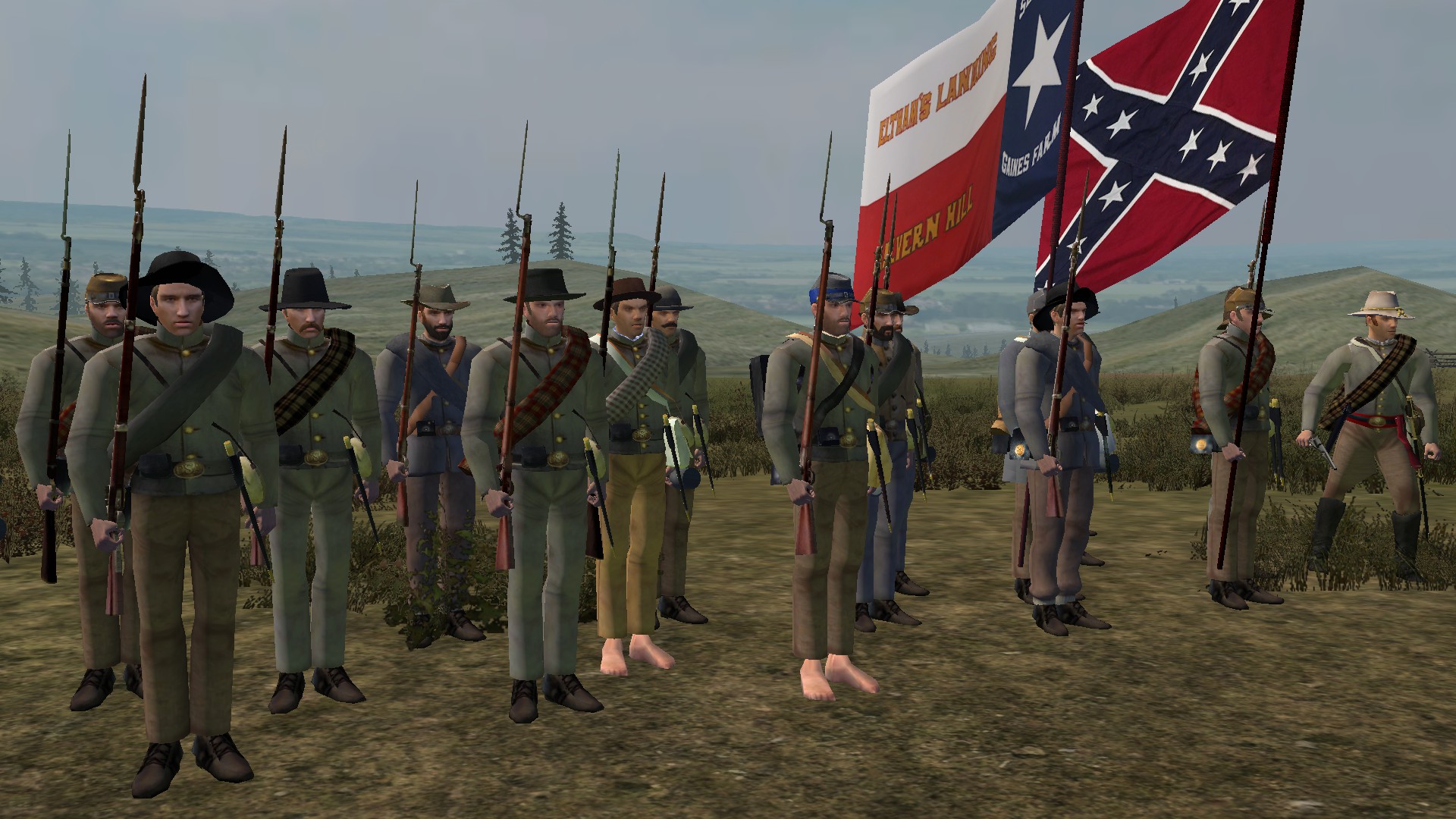
Weapons: (Buck & ball/rifle mix) Pattern 1853 Enfield Rifle Musket, Springfield Model 1842 Smoothbore Musket, Springfield Model 1855 Rifle Musket, Springfield Model 1822 Smoothbore Musket, Springfield Model 1816 Flintlock Musket, Springfield Model 1835 Flintlock Musket, M1841 Mississippi Rifle, Springfield Model 1861 Rifle Musket
Faction: Army of Northern Virginia
Current Commander: Lieutenant General John Bell Hood
Recruitment Locations: Richmond, Fredericksburg, Houston, Shepherdstown, Chancellorsville, Blair's Landing, Norfolk, Manassas, Winchester, Dinwiddie Court House, Mechanicsville, Charleston VA, Corpus Christi
Hood's Texas Brigade was an infantry unit that, along with the Stonewall Brigade, were distinguished among the Confederate Army and considered it's shock troops. They fought in every major battle of the Eastern Theater except for Chancellorsville. The brigade distinguished itself during the Seven Days Battle where it routed Union troops at Gaines' Mill, captured a battery of guns, and repulsed a cavalry counterattack. Casualties at Gaines Mill were severe, amounting to at least 25% of the Texas Brigade's total strength.
Its reputation increased when it spearheaded Longstreet's assault on Pope's left at the battle of Second Manassas. The brigade overran two Union regiments, nearly annihilated the 5th New York Zouaves, and captured a battery of guns, losing 628 men in the battle. Its reputation for fighting was sealed at the Battle of Antietam (Sharpsburg), when it closed a gap in the Confederate line and drove back the two Union Corps that were attacking. Out of 854 that went into battle at Antietam, 550 of the Texas Brigade were killed or wounded.
The brigade's most famous action took place on the second day of the Battle of Gettysburg, during its fight for Devil's Den. Though the Confederacy ultimately lost that battle, the 1st, 4th, and 5th Texas, as well as the 3rd Arkansas distinguished themselves in taking Devil's Den, despite being greatly outnumbered and suffering heavy casualties, including their commander, General Jerome B. Robertson, who was wounded in the fighting. The brigade's failure to take Little Round Top marked the failure of that day's fighting.
By the war's end, of the estimated 5,353 men who enlisted in the three Texas and one Arkansas regiments that made up the Texas Brigade, only 617 remained to surrender on April 9, 1865, at Appomattox Court House.
Virginia
Stonewall Brigade Infantry
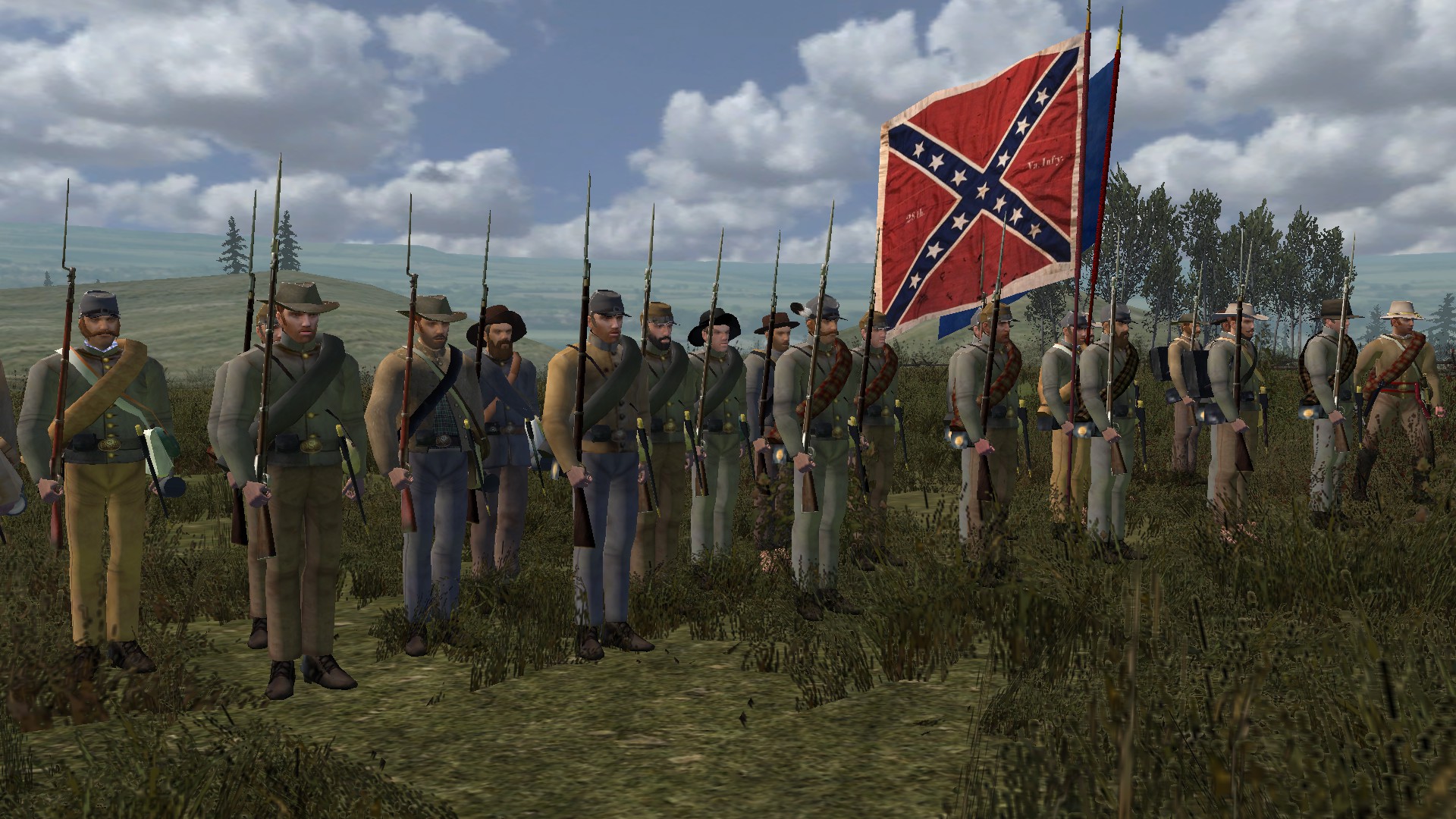
Weapons: (Buck & ball/rifle mix) Pattern 1853 Enfield Rifle Musket, Springfield Model 1855 Rifle Musket, Springfield Model 1842 Smoothbore Musket, Springfield Model 1861 Rifle Musket, Richmond Rifle
Faction: Army of Northern Virginia
Current Commander: Lieutenant General Thomas J. "Stonewall" Jackson
Recruitment Locations: Richmond, Fredericksburg, Shepherdstown, Petersburg, Chancellorsville, Lynchburg, Williamsburg, Norfolk, Manassas, Gordonsville, Winchester, Dinwiddie Court House, Mechanicsville, Charleston VA
The Stonewall Brigade was one of the most famous infantry units in United States Military history. It was trained and first led by General Thomas J. "Stonewall" Jackson, whose severe training program and strict standards of military discipline turned enthusiastic, raw recruits into an effective military organization, which distinguished itself from the First Battle of Bull Run (First Manassas) in 1861, to Spotsylvania Court House in 1864.
Jackson's brigade was referred to informally as "Virginia's First Brigade" until their fight at First Manassas, where both the brigade and its general received the nickname "Stonewall". General Barnard E. Bee of South Carolina is said to have made his immortal remark as he rallied his brigade for the final phase of the battle. Although the exact words were not recorded at the time, it is thought he probably said, "There stands Jackson like a stone wall. Rally behind the Virginians!" This is considered the turning point of the first major battle of the war; Union troops were repulsed and sent reeling back toward Washington D.C. in defeat.
At Spotsylvania Court House, the brigade was on the left flank of the "Mule Shoe" salient, in the part of the line known as the "Bloody Angle", where Winfield S. Hancock's II Corps launched a massive assault. All but 200 men of the Stonewall Brigade were killed, wounded, or were among the 6,000 captured following the bloody hand-to-hand fighting. The Stonewall Brigade was officially dissolved after Spotsylvania and consolidated into a single regiment.
The remaining regiment fought as part of Brigadier General William Terry's brigade (which itself was the remnant of the Stonewall Division) in the Valley Campaigns of 1864 under Jubal A. Early. Early's army was eventually defeated in the Valley by Philip Sheridan and they rejoined Robert E. Lee and the Army of Northern Virginia for the Siege of Petersburg and the Appomattox Campaign. Of the 6,000 men who served in the Stonewall brigade during the war, by the time of the surrender at Appomattox Court House, only 219 soldiers were left, none above the rank of captain.
4th Virginia Infantry "Liberty Hall Volunteers"
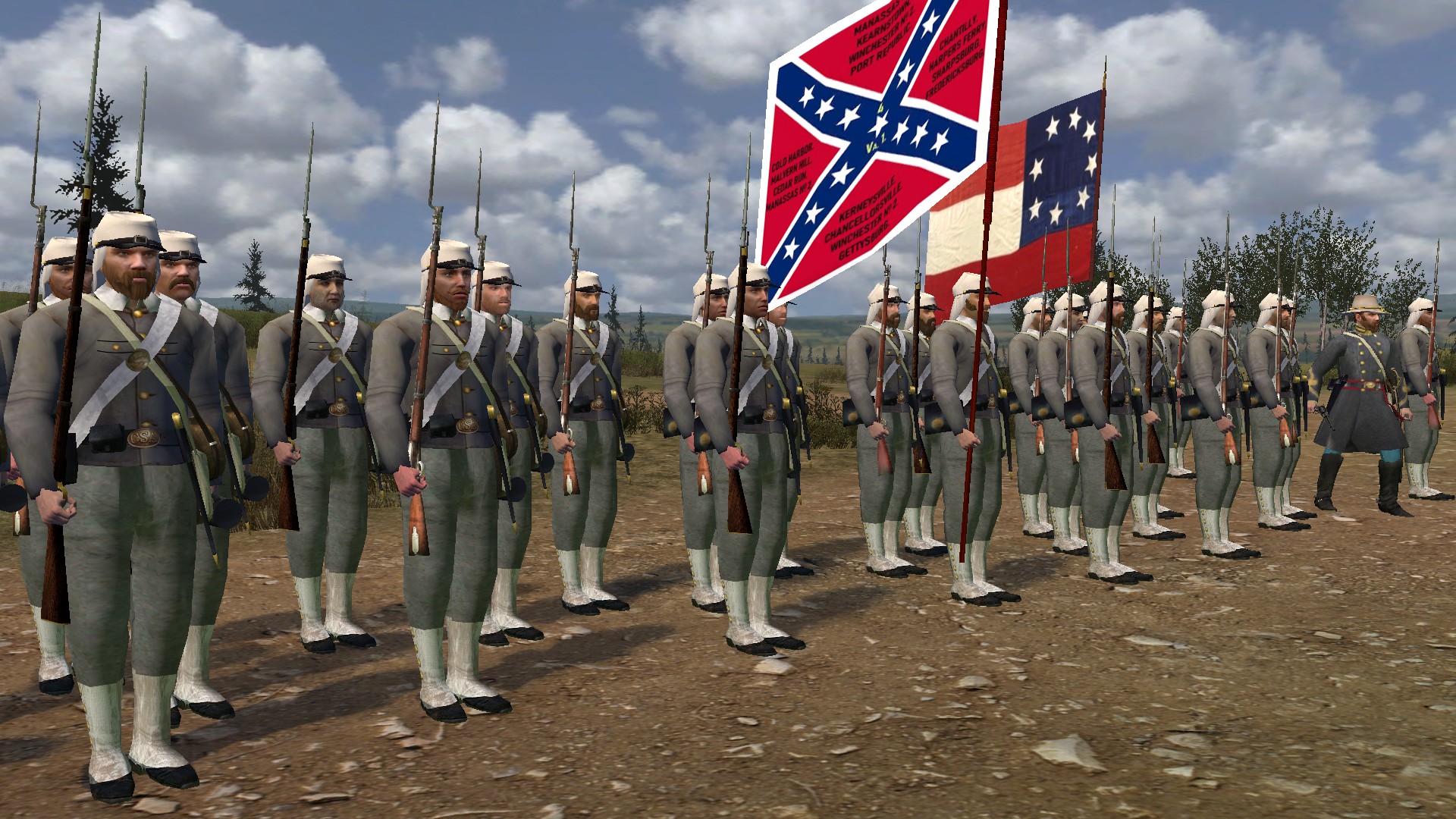
Weapons: Pattern 1853 Enfield Rifle Musket, Springfield Model 1855 Rifle Musket, Springfield Model 1861 Rifle Musket, Richmond Rifle
Faction: Army of Northern Virginia
Current Commander: Brigadier General William Mahone
Recruitment Locations: Richmond, Fredericksburg, Shepherdstown, Petersburg, Lynchburg, Williamsburg, Norfolk, Manassas, Gordonsville, Winchester, Dinwiddie Court House, Charleston VA
The 4th Virginia Volunteer Infantry Regiment was assembled at Winchester, Virginia, in July, 1861, under the command of Colonel James F. Preston. Its companies were from the counties of Wythe, Montgomery, Pulaski, Smyth, Grayson, and Rockbridge, and Company I was nicknamed the, "Liberty Hall Volunteers". This name came about because many of the members of Company I were students from Washington College in Lexington, Virginia, and at the time of the Civil War, Washington College was known as Liberty Hall Academy. The volunteers took pride in their association with the institution, and so chose the name. The 4th Virginia joined with other Virginia regiments to form the First Brigade of Virginia (nicknamed the "Stonewall Brigade" following the First Battle of Manassas).
The regiment fought at First Manassas, and their stout defense of Henry House Hill during that engagement led South Carolina General Barnard Bee to characterize their commander, General Thomas J. Jackson as a "stone wall", hence the brigade's name. The regiment's 31 dead and 100 wounded were the highest losses in the brigade. The 4th's men recovered and drilled for the next few months, and by March 1862, the unit was only about a third of its normal strength due to sickness and resignations, but still fought in the First Battle of Kernstown until its ammunition ran out, with 5 men killed and 23 wounded. That spring, the unit participated in Jackson's Valley Campaign, marching 646 miles in 28 days, fighting 4 battles and 6 skirmishes. The 4th Virginia was only peripherally involved during the first battle at Front Royal and the First Battle of Winchester, however, the Stonewall Brigade delivered the primary assault at Port Republic, and this unit lost only four men wounded.
As part of the Army of Northern Virginia during the Seven Days' Battles, the regiment participated in the Battle of Gaines' Mill and the Battle of Malvern Hill on July 1st, 1862, losing 8 men killed and 48 wounded in the campaign. Malaria, heat and skimpy rations took a higher toll before the Battle of Cedar Mountain on August 8th, 1862, where the unpopular General Charles S. Winder was mortally wounded along with 3 men of this unit being killed and another 6 wounded. At the Battle of Second Manassas, of the 180 effectives, 78 were wounded, including Major William Terry, but the unit was in high spirits from the Confederate victory in the battle. At the Battle of Antietam, the regiment lost 3 men killed and 3 wounded. It lost another 3 killed and 14 wounded in a skirmish at Kearneysville, at which Colonel Charles A. Ronald suffered a thigh wound which ended his military career. By December, the 4th Virginia was suffering from a smallpox epidemic and so was in reserve during the Battle of Fredericksburg. However when the Federals breached Jackson's line, they were called into action, and acquitted themselves well, despite losing 12 men wounded.
On May 2nd – 3rd, 1863, the Stonewall Brigade lost 48% (160 men) of the 355 engaged at Battle of Chancellorsville, including Brigadier General E. Franklin Paxton, who fell dead personally leading the brigade early in the battle. The 4th Virginia's casualties were the highest of any regiment in the brigade, but the greatest loss was hearing of General Jackson's death from pneumonia following his wounding by friendly fire. During the Battle of Gettysburg, the Stonewall Brigade participated in the fighting on Culp's Hill, but the 4th Virginia again suffered the heaviest losses within the brigade, losing 18 men killed, 50 wounded and 69 captured, as well as their battle flag. Only 66 men were left in the regiment to return across the Potomac River. During the winter of 1863 – 1864, most of the men in the Stonewall Brigade lacked shoes and socks, and rations were in very short supply. Conscripts, recruits and soldiers from other units were assigned to fill its ranks, so the 4th Virginia reached maybe 200 men. At the Battle of Spotsylvania, the regiment was trapped at the Bloody Angle and lost 7 men killed, 6 wounded and 126 captured, which led the Stonewall Brigade to cease existing as an independent unit.
The remains of the Stonewall Brigade, including the 4th Virginia, were consolidated into a new brigade under General William Terry, and joined the Second Corps under General Jubal Early in the Shenandoah Valley, and threatened Washington D.C., but were hopelessly outnumbered as they retreated, and lost the Third Battle of Winchester, with the 4th Virginia suffering 3 wounded and 8 captured. Another two men were lost at the Battle of Fisher's Hill, and at the Battle of Cedar Creek, one man was killed, 5 wounded and 4 captured. Terry's Brigade was assigned to join Robert E. Lee's besieged army at Petersburg and also saw action around Appomattox in the war's final days as Lee frantically sought to resupply his army.
At the surrender at Appomattox, the only staff officer left from the 4th Virginia was assistant Surgeon John A. Field. By this time, Captain Hamilton D. Wade had recovered from his wounds and was the senior field officer at the time, with 5 lieutenants and 38 men (of whom only 17 were armed). John P. Moore of the Liberty Hall Volunteers became the unit's last battle fatality, during the final attempt to break out from the encircling Union forces on Palm Sunday, April 9th, 1865, shortly before General Lee decided to surrender. Though it suffered heavy losses, two surviving officers resumed political careers after the conflict and won election to the U.S. House of Representatives, and several more served in the Virginia General Assembly.
Sharpshooters & Light Infantry
Georgia
2nd Battalion Georgia Sharpshooters
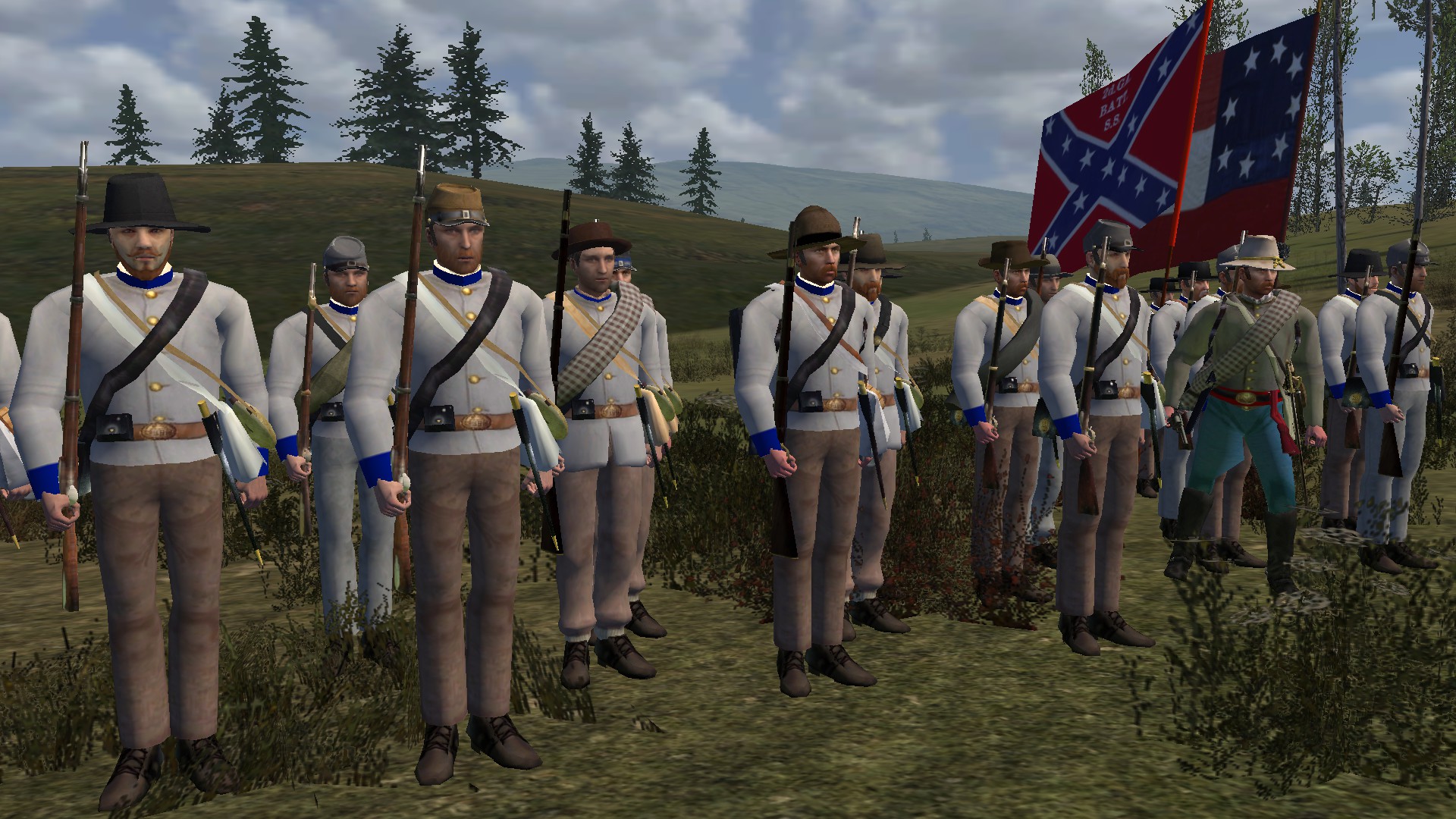
Weapons: Pattern 1856 Enfield "Short Rifle", Fayetteville Rifle Musket Type III, Fayetteville Rifle Musket Type IV, Richmond Rifle, Springfield Model 1861 Rifle Musket, Springfield Model 1855 Rifle Musket, M1841 Mississippi Rifle
Faction: Army of Northern Virginia
Current Commander: Lieutenant General Theophilus H. Holmes
Recruitment Locations: St. Augustine, Tallahassee, Atlanta, Savannah, Fort Wagner, Calhoun, Augusta, Fort Ward, Fort Marion, Macon, Brunswick, Tampa, Madison, Olustee, Gainesville, Jacksonville, Murphy, Athens, Cedar Shoals
The 2nd Battalion of Georgia Sharpshooters was formed in the summer of 1862, and consisted of six companies under the command of Major J. J. Cox. The men were from various sections of the state and many had seen prior service. It was assigned to General J.K. Jackson's Brigade and distinguished itself in the fighting at Murfreesboro, Chickamauga and Missionary Ridge. The battalion was later brigaded under Brigadier General States Rights Gist (yes, his actual name was States Rights) taking an active part in the Atlanta Campaign, Franklin, Nashville and the Carolina Campaign. The strength of the battalion numbered 152 men in December 1862. By December 1863, the battalion numbered 80 men and 65 arms. Very few were left to surrender with the Army of Tennessee in March 1865.
Despite advancements in firearms technology, proficiency at long distance shooting requires extensive training, which many sharpshooter units did not receive, and as a result sharpshooters during the Civil War would not uniformly adopt tactics akin to modern day marksmen. On the Confederate side, sharpshooter units functioned as light infantry, with their duties including skirmishing and reconnaissance. Confederate sharpshooters were often less well equipped than their Union counterparts, commonly using the muzzle loading Pattern 1853 Enfield Rifle, however during the course of the American Civil War, the Pattern 1856 Enfield "Short Rifle" became extremely popular with Confederate sharpshooter battalions because it was short, handy, and easier to maneuver through the brush in the woods. The rifle carried by Sergeant Richard Kirkland of the 2nd South Carolina Infantry, better known to history as the "Angel of Marye's Heights", was one such JS/Anchor marked Pattern 1856 No. 2, with the number 2370 engraved on the butt plate. This gun is on display in Columbia, South Carolina at the South Carolina Relic Room & Military Museum.
Missouri
Pindall's Missouri Sharpshooters
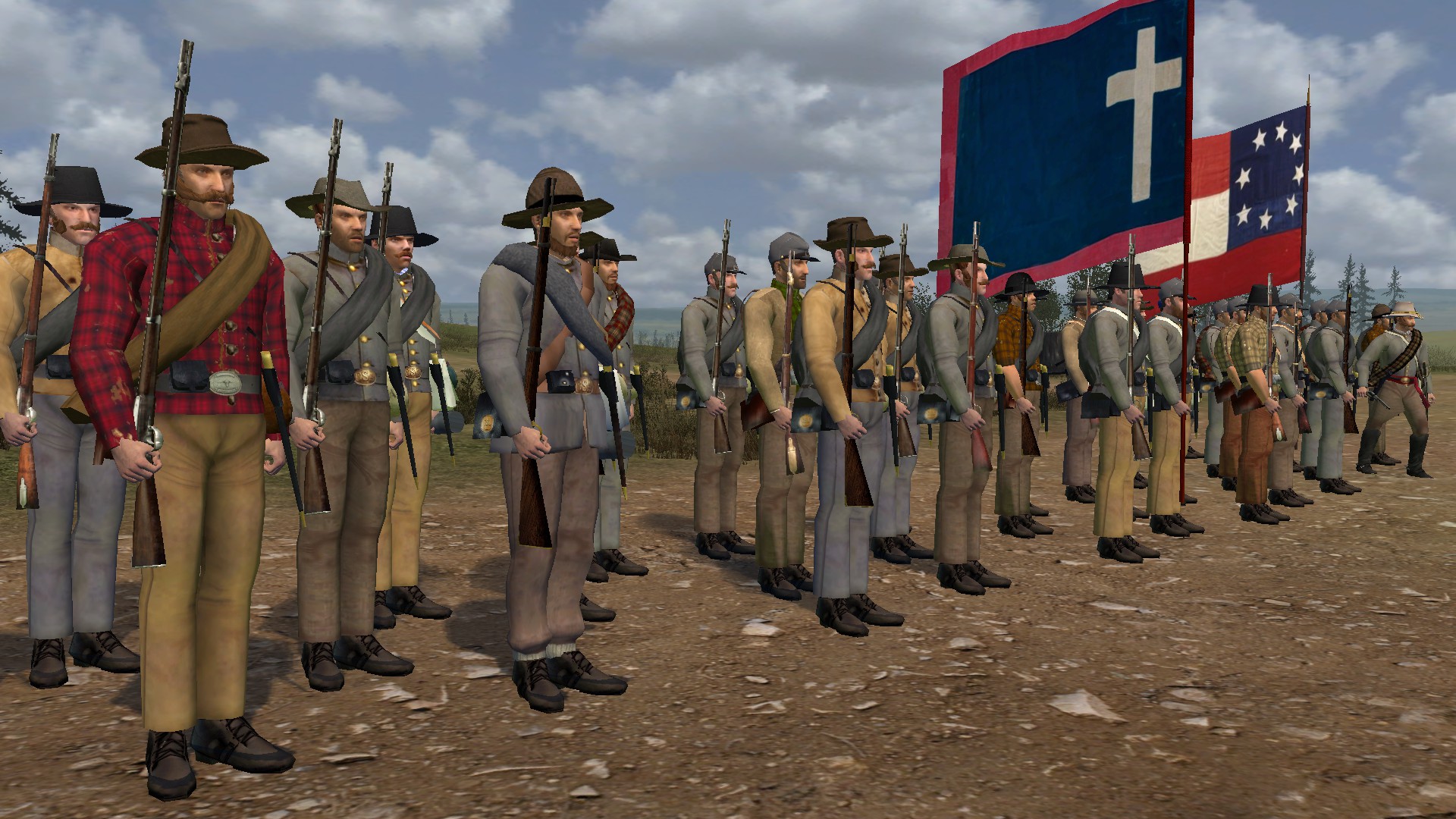
Weapons: Pattern 1856 Enfield "Short Rifle", Pattern 1853 Enfield Rifle Musket, Springfield Model 1861 Rifle Musket, Springfield Model 1855 Rifle Musket, Springfield Model 1842 Smoothbore Musket, Fayetteville Rifle Musket Type IV, Richmond Rifle, M1841 Mississippi Rifle
Faction: Army of Tennessee
Current Commander: Major General John Porter McCown
Recruitment Locations: Jackson, Vicksburg, Corinth, Memphis, Little Rock, Fort Donelson, Shreveport, Fort Henry, Meridian, Greenville, Paducah, Pea Ridge, Tupelo, Tuscaloosa
On April 21st, 1862, the Confederate States Congress authorized each brigade of infantry to be assigned a battalion of sharpshooters. Per law, these battalions were to be armed with long-range rifles and were to consist of three to six companies. On November 25th, Major General Thomas C. Hindman ordered his subordinate division commanders to form the sharpshooter battalions if practical. One of Hindman's division commanders, Brigadier General Mosby Monroe Parsons, had two weeks earlier formed a sharpshooter company to serve with a brigade of Missouri troops. Two more sharpshooter companies were formed on November 29th, and the three were consolidated together into a battalion commanded by Major Lebbeus A. Pindall, at a camp near Fort Smith, Arkansas. Nothing indicates that the soldiers possessed any particular marksmanship abilities or met any other special qualifications for assignment to the battalion. In fact, the original company consisted of men assigned from a disbanded artillery battery and a company of partisan rangers, while the other two filled their ranks from the infantry regiments of Parsons' brigade.
The unit's first major battle was the Battle of Prairie Grove in December 1862. In the afternoon on December 7th, Parsons' brigade moved to the front, but Hindman ordered Pindall's battalion to remain in the rear near a church with Tilden's Missouri Battery. It remained in the rear for about an hour, but was ordered forward when Parsons requested support for his right flank. Parsons ordered an attack, which had some success. Shortly before sunset, Parsons ordered another attack, but it was repulsed. No surviving official report by Pindall about the unit's actions during the battle is known to exist, and the battalion suffered only three casualties during the fighting, all wounded.
The first half of 1863 saw the battalion serving at various points in Arkansas, however when a Confederate force attacked the Federal-held city of Helena, Arkansas, on July 4th, in an attempt to relieve some of the pressure on Vicksburg, Mississippi, the 9th Missouri Sharpshooters were put into action. At daylight on July 4th, Pindall's battalion drove in the Federal skirmish line and led Parson's brigade in the assault on "Battery C" atop Graveyard Hill, pinning down the artillery crews with their fire. Once the brigade charged forward, it quickly overcame the defenders and drove them into Helena. The brigade enjoyed only short-lived success, however, for it received no support on either flank and soon experienced the full brunt of their opponent's firepower. Parsons' men could not endure the fire and hastily retreated, with the sharpshooters covering their withdrawal. Pindall's sharpshooters suffered 14 men killed or mortally wounded, 22 wounded, and 8 missing at Helena, and mustered only 190 men present the following day.
The battalion was present in the Little Rock area during the Little Rock Campaign later in the year, but saw no action. In March 1864, it moved into Louisiana to oppose the Red River Campaign, during which it fought at the Battle of Pleasant Hill in early April. It is likely that the Confederate War Department officially designated the battalion as the 9th Missouri Sharpshooter Battalion at about this time as well. After Pleasant Hill, the battalion returned to Arkansas and was engaged at the Battle of Jenkins' Ferry on April 30th. The battalion spent the rest of the war at various points in Louisiana and Arkansas before the Confederate forces in the Trans-Mississippi Theater surrendered on May 26th, 1865. The battalion was sent back to Missouri on the steamboat Kentucky, but tragically the vessel sank in the Red River during the trip, and at least 12 men of the battalion died in the wreck.
South Carolina
Hampton's Legion "Washington Light Infantry"
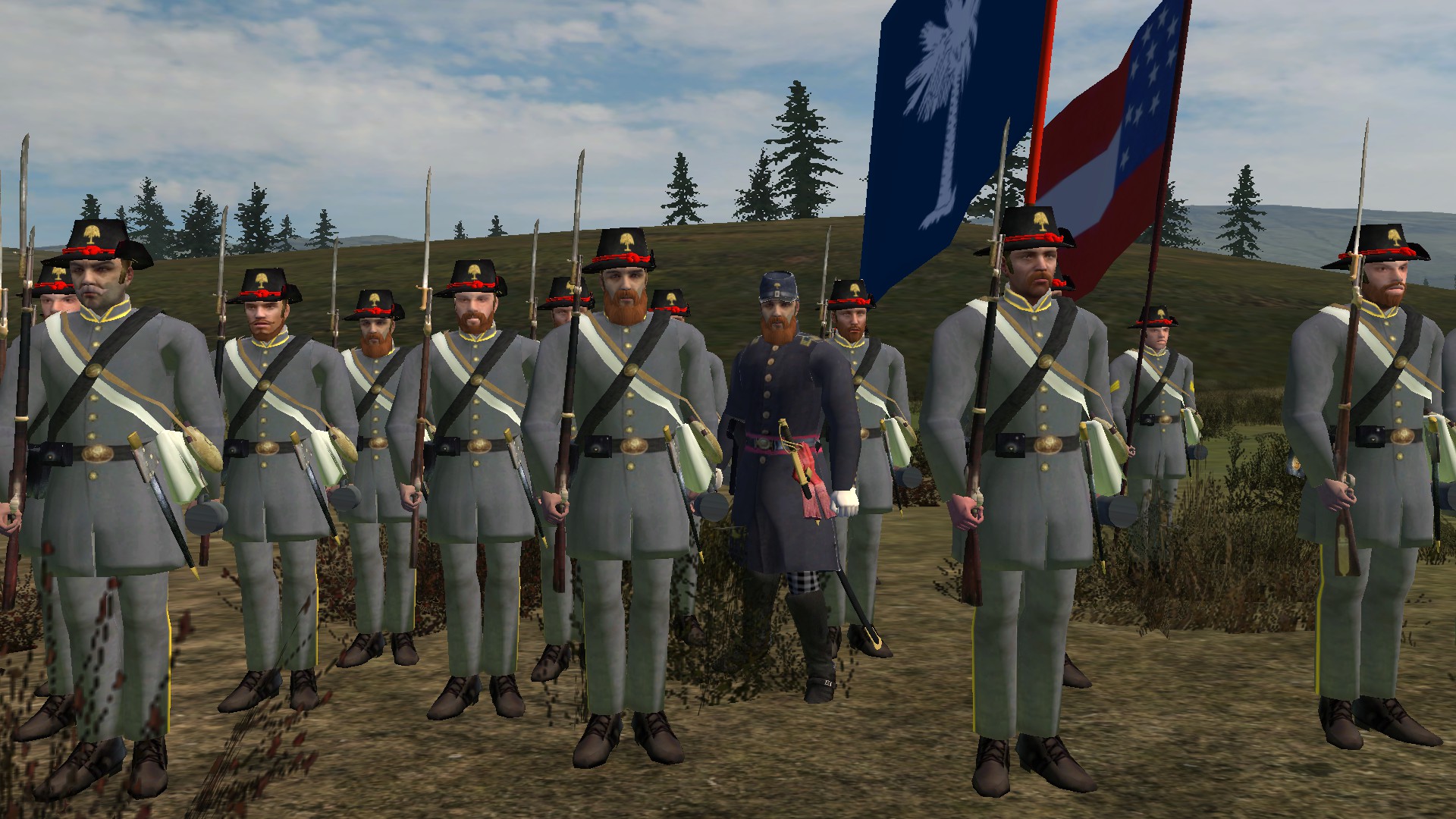
Weapons: Fayetteville Rifle Musket Type III
Faction: Army of Northern Virginia
Current Commander: Major General Jubal A. Early
Recruitment Locations: Charleston, Raleigh, Knoxville, Salem, Fort Macon, Fort Fisher, Charlotte, New Bern, Camden, Wilmington, Fayetteville, Winston-Salem, Newport, Hillsborough, Kingstown, Columbia, Sandy Springs, Roanoke Rapids
Organized and partially financed by wealthy South Carolina planter Wade Hampton III in the summer of 1861, Hampton's Legion was initially composed of six companies of infantry, two of cavalry, and one of light artillery, with elements of Hampton's Legion participating in virtually every major campaign in the Eastern Theater, from the first battle to the last. Hampton had no military experience at all, but had a natural ability that made him an outstanding leader and one of the best Confederate generals in the war. Hampton financed all of the Legion's weapons himself, and the unit had some of the finest uniforms among all of the early war volunteers. A legion historically consisted of a single integrated command, with individual components including infantry, cavalry, and artillery. The concept of a multiple-branch unit was never a practical application for armies in the American Civil War and, early in the war, the individual elements were assigned to other organizations. Hampton's Legion initially boasted a large number of South Carolina's leading citizens, including future generals J. Johnston Pettigrew, Stephen Dill Lee, Martin W. Gary, and Matthew C. Butler.
The Legion's infantry fought in the First Battle of Manassas, where Colonel Hampton suffered the first of several wounds during the war. In November 1861, the artillery was outfitted with four Blakely Rifles, imported from England and slipped through the Union blockade into Savannah, Georgia. By the end of the year, each element of the Legion had been expanded with new companies to bolster the effective combat strength. With the reorganization of the Army of Northern Virginia in mid-1862, Hampton's Legion was broken up and reassigned. The cavalry battalion was consolidated with the 4th South Carolina Cavalry Battalion and two independent companies on August 22nd, 1862, and became the 2nd South Carolina Cavalry under Colonel Butler. It remained directly under General Hampton's control and served in his brigade and then division for the rest of the war. The artillery was converted to horse artillery and renamed "Hart's Battery", after its commander, Captain James F. Hart. Lieutenant Colonel Gary's infantry element, retaining the designation Hampton's Legion, was initially brigaded with Georgia troops in Stonewall Jackson's command, but was transferred in June to John Bell Hood's "Texas Brigade".
The various elements of the Legion fought in most of the major Eastern operations of 1862, including the Peninsula, Northern Virginia, and Maryland campaigns, suffering substantial losses. The Legion helped to dislodge Union forces at the Battle of Chinn Ridge, and the Second Battle of Bull Run, and to inflict a horrific number of casualties on the 5th New York Regiment. Battered at Antietam, the much depleted Legion infantry was sent to the rear and performed garrison duty for months while refitting and recruiting. It did not participate actively in the early part of the Gettysburg Campaign, unlike the cavalry and artillery elements, which played a major role in several battles during the campaign. It fought a minor rearguard action at Boonsboro, Maryland, during the army's retreat from Gettysburg. It returned to action in the fall of 1863 in Longstreet's Corps during the Battle of Chickamauga and the subsequent Chattanooga campaign. The Legion infantry later returned to Virginia and in March 1864, it was converted to mounted infantry and assigned to Gary's Cavalry Brigade in the Department of Richmond. They served in that department, until January 1865 when the brigade was reassigned to Fitzhugh Lee's Cavalry Division. It harassed Federal supply depots throughout northern Virginia, and fought in several actions during the lengthy Siege of Petersburg.
What was left of the Hampton Legion infantry surrendered with General Robert E. Lee at Appomattox Court House in early April 1865. The South Carolina cavalry regiment and the horse artillery (by then renamed as "Halsey's Battery" after Captain Hart's wounding) participated in the Carolinas Campaign with General Hampton and surrendered at Bennett Place in North Carolina along with the rest of General Joseph E. Johnston's forces on April 26th.
Virginia
17th Virginia Infantry "Warrenton Rifles"
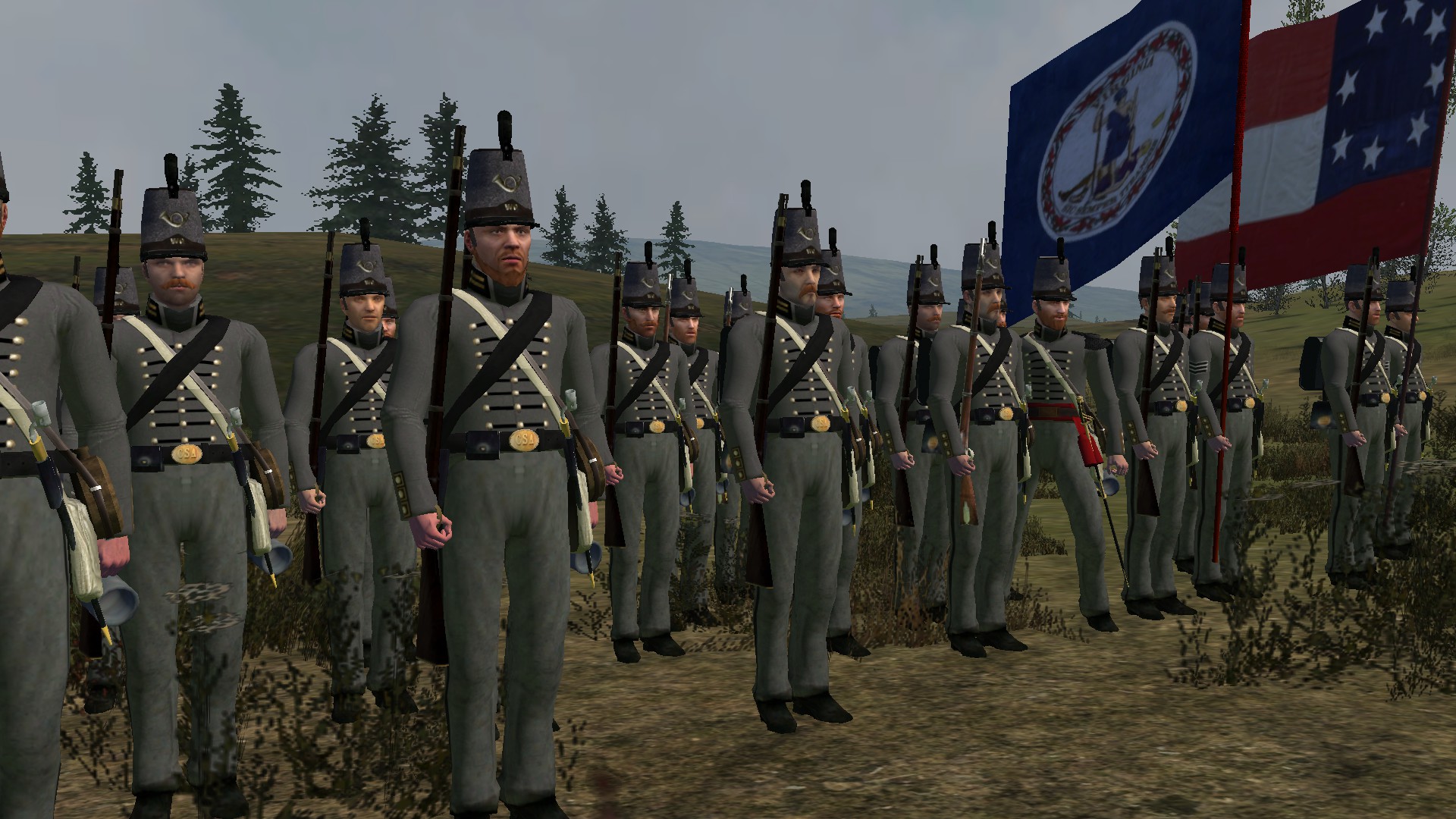
Weapons: Pattern 1853 Enfield Rifle Musket, Springfield Model 1855 Rifle Musket
Faction: Army of Northern Virginia
Current Commander: Brigadier General Winfield S. Featherston
Recruitment Locations: Chancellorsville, Lynchburg, Williamsburg, Norfolk, Manassas, Gordonsville, Dinwiddie Court House, Mechanicsville, Charleston VA
The 17th Virginia Infantry was organized at Manassas Junction on June 10th, 1861. It was composed of ten companies, many of which began as pre-war volunteer militias. The core of these volunteers were four companies organized on February 18th, 1861 as a volunteer militia battalion; the Mount Vernon Guard, Alexandria Riflemen, Old Dominion Rifles, and the Alexandria Artillery. On April 2nd, the General Assembly passed an act authorizing a battalion be raised in the city of Alexandria with three companies of infantry and one of artillery. On April 4th, Captain Montgomery Dent Corse of the Old Dominion Rifles was unanimously elected to command the battalion with the rank of Major.
The oldest company, the Mount Vernon Guard, was organized on June 21st, 1842, but always observed July 4th as their anniversary. The Alexandria Riflemen were organized on March 10th, 1856, originally choosing the name "Alexandria Sharp Shooters". They quickly reconvened their meeting when some realized how the initials would look painted on the back of their knapsacks. The change of name to "Alexandria Riflemen" was unanimous. They were organized, with the Mount Vernon Guard, into a volunteer battalion under the command of Major Turner Wade Ashby, who had been a lieutenant in Captain Corse's company during the Mexican-American War. The Old Dominion Rifles were organized on December 6th, 1860, and organization was complete by January 7th, 1861, with the election of Corse as captain and Arthur Herbert as lieutenant. The Alexandria Artillery was formed in 1850 as the Mechanical Artillery, with the new name of Alexandria Artillery being adopted in 1856.
After John Brown's raid on Harpers Ferry, John Quincy Marr organized the "Warrenton Rifles" militia company, which became Company K of the 17th Virginia Infantry Regiment. In early 1861, Fauquier County voters elected Marr as a delegate to the Virginia Secession Convention. Although initially opposed to secession, and called home by a "family affliction" during the deliberations, he later signed the ordinance of secession. The Warrenton Rifles were accepted into state service at Warrenton, in Fauquier County, Virginia, on April 22nd, 1861. On Saturday, June 1st, 1861, the first land engagement of the American Civil War with fatal casualties took place; the Battle of Fairfax Court House. A company of Union cavalry on a scouting mission entered the streets of Fairfax Court House after driving back one Confederate picket and taking another prisoner.
At that time, two companies of cavalry and Captain Marr's Warrenton Rifles infantry company occupied the town. The Confederate cavalry began to retreat and cut off part of the Warrenton Rifles from those who faced the Union cavalry charge. Only about 40 men from the company were in a position to combat the Union cavalrymen. Lieutenant Charles Henry Tompkins of the 2nd U.S. Cavalry Regiment led the Union force of between 50 and 86 men who separated into two groups as they rode through the village. Captain Marr challenged the riders, asking, "What cavalry is that?" These were his last words. Scattered shots were fired as the Union cavalry rode through and Captain Marr fell dead, making him the first Confederate officer killed in the American Civil War. Marr was not in the immediate presence of any of his men on a dark night so soon after he fell, no one knew where he was or what may have happened to him. His body was found later in the morning.
After Marr fell, the former and subsequent governor of Virginia, and later major general, William "Extra Billy" Smith, who had just resigned his seat in the U.S. Congress, took command in the absence of the company's leaders. Smith was actually from Warrenton and had helped raise the Warrenton Rifles. Soon thereafter Lieutenant Colonel (later Lieutenant General) Richard S. Ewell, who had just been placed in charge of Confederate forces at Fairfax Court House, came upon the company. Ewell had received a wound to the shoulder as he emerged from the village's hotel as the Union cavalry first rode through the streets, so he was bleeding as he took charge of the Warrenton Rifles in the field and redeployed 40 of them. Ewell soon went off to send for reinforcements and Smith redeployed the men again in the same general area but in a less exposed position about 100 yards forward.
After the Union cavalry rode through the village, they regrouped and returned through the village streets. A volley from the redeployed men of the Warrenton Rifles turned them back. The Confederates fired additional volleys at the Union cavalry as they tried to pass through town again on their way back to their base near Falls Church, Virginia. After a third failed attempt to ride past the Confederates, the Union cavalry were forced to leave town with several wounded men, toward Flint Hill in the Oakton area of Fairfax County to the north of the city of Fairfax. Confederate casualties in the affair were one dead, four wounded, including Lieutenant Colonel Ewell, and one missing, according to their report. A later account states that only two were wounded, but five were captured. Union forces lost one killed, identified as Private Saintclair, four wounded, including Lieutenant Tompkins, and three missing, who had been taken prisoner.
Captain Marr's body arrived in Warrenton that evening. The following afternoon, a large crowd attended a ceremony in the clerk's office yard before his burial in the Warrenton Cemetery. Charles Henry Tompkins received the Medal of Honor for his actions at Fairfax Court House. His was the first action of a Union Army officer in the American Civil War for which a Medal of Honor was awarded, though not until 1893. His citation reads: "Twice charged through the enemy's lines and, taking a carbine from an enlisted man, shot the enemy's captain." No other account states that Tompkins personally shot Captain Marr.
During the fighting at First Manassas, the 17th was in a brigade under James Longstreet, and Captain B. H. Shackelford of the Warrenton Rifles, was shot in the ankle by a canister ball, but he bandaged the wound and remained upon the field until the end of the battle. The regiment was afterwards assigned to General Ewell's, A.P. Hill's, Kemper's, and Corse's Brigade. The 17th fought with the Army of Northern Virginia from Williamsburg to Fredericksburg, then participated in Longstreet's Suffolk Expedition. During the Gettysburg Campaign it was on detached duty at Gordonsville and later served in Tennessee and North Carolina. Returning to Virginia it fought at Drewry's Bluff and Cold Harbor, saw action in the Petersburg trenches, and ended the war at Appomattox. This regiment totaled 600 men in April, 1862, lost 17 killed and 47 wounded at Williamsburg, had 18 killed and 41 wounded at Seven Pines, and had 17 killed, 23 wounded, and 73 missing at Frayser's Farm. It reported 48 casualties at Second Manassas, 13 at South Mountain, and of the 55 engaged at Sharpsburg, about 75% percent were disabled. At Drewry's Bluff, 7 were killed and 23 wounded. Many were captured at Sayler's Creek, and 2 officers and 46 men surrendered on April 9th, 1865.

